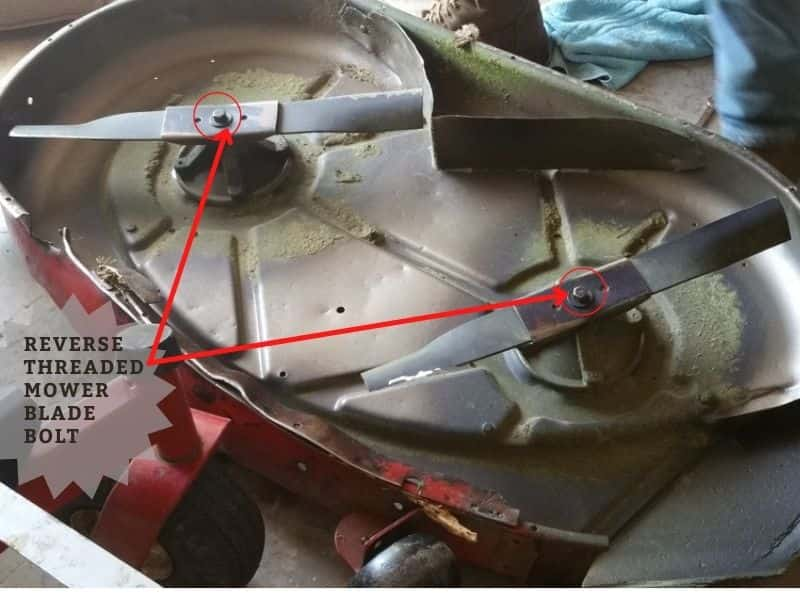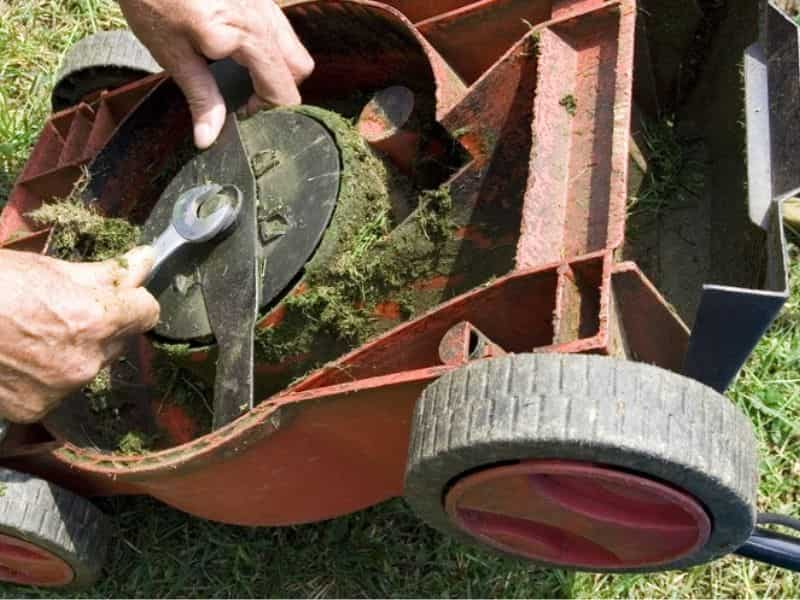Are Lawn Mower Blades Reverse Threaded? Bolt Direction Guide
Nuts, bolts, and screw fasteners are often right-hand threaded to join the parts of machines or equipment. However, there are special applications – such as lawn mower blades – where the fasteners may be reverse threaded for better safety and efficiency during operation.
Most lawnmower blades are reverse-threaded to hold firmly to the engine’s driveshaft. Lawn mowers operate by rotating the blade beneath to cut the grass. Continuous fastening adds more safety as the rotating bolt holds the blade tightly, otherwise, it can injure the person operating it.
It’s vital to know your mower blade bolt’s direction of rotation to unscrew the bolts or fix the blade effortlessly.
What is reverse threading?
Reverse threading is a fastening method where threads in the retaining bolts wrap around the shaft counterclockwise. Blades of a reverse threaded mower appear to turn to the right if observed from the mower’s top while mowing.
Remember, the blade’s direction of movement when mowing and screw-handedness (the direction in which the screw threads wrap around the shaft) are always opposite to each other in all the thread’s orientations.

Threads, defined as the continuous spiral ridges on the bolt, move from the bottom, pitching towards the left in reverse threads. Observing this direction will help you determine if your mower blade bolts are reverse threaded or not. Reverse threading is also called left-hand threading, which shows the threads pitching towards the left direction.
Fasten reverse threaded mowers by rotating the bolts towards the right but to the left when loosening.
Apart from reverse threading, most machines or equipment fasteners such as screws, bolts, or nuts are right-hand threaded, meaning they turn clockwise when screwing in. Their threads wrap around the shaft from the bottom, pitching upwards to the right.
Use the pitching direction to determine if your mower blade bolts are right-handed. Right-handed mower blades move towards the left when mowing. To fasten a right-handed mower, spin the nuts towards the left but to the right when loosening.
Are mower blades reverse threaded?
Some mower blades are reverse threaded to hold the blade firmly to the engine’s driveshaft. As the blade rotates when cutting grass, the bolt moves to the right, fastening the blade tightly to the driveshaft. Continuous fastening adds more safety as the rotating bolt holds the blade tightly, otherwise, the blade can injure the person walking behind push mowers.
Note that not all mowers are reversely threaded to secure the blade. For example, Cab Cadet is a right-hand threaded drive on a mower. Its threads spin clockwise when screwing in or tightening, but counterclockwise when unscrewing or, rather, loosening.
See More; Self-Propelled vs Push Lawn Mower
Which way does a lawn mower blade unscrew?
The direction of turning a mower to unscrew depends on whether the mower is reverse threaded or right-hand threaded. Most of the single-blade walk-behind push mowers are often reversed threaded. Their blades turn to the right when mowing, while their threads turn clockwise and are fastened by turning the retaining bolt to the right.

To unscrew the retaining bolts from a reverse threaded mower, turn the retaining bolts to the opposite direction, that is, the left, counterclockwise direction. Remove the blade after unscrewing and replace it with a new or sharpened one.
Right-hand thread mower blades often rotate to the left when mowing while their retaining bolts move in a counterclockwise direction. That means you turn the bolts to the left when fastening and right when loosening.
To unscrew a right-hand threaded bolt mower, rotate the retaining bolt to the right or clockwise.
Some twin-blade mowers are both left-hand threaded and right-hand threaded. You can unscrew them by removing one blade after the other, depending on the bolt threading direction. Turn the left-hand thread retaining bolt to the left while the right-hand thread bolt to the right unscrew them.
Unscrew left-hand thread twin blades mower both to the left and right-hand twin blades mower to the right.
Why are lawn mower blades reverse threaded?
Screw threads are often assumed to be right-hand threaded unless otherwise specified as left-hand. However, most lawnmower blades are reverse threaded. Lawn mowers operate by rotating the blade beneath to cut the grass. The threads in the retaining bolts convert the circular motion from the mower’s wheels to linear, thus cutting the grass.
If the mower’s blade bolts were right-hand threaded, they would loosen as the blade rotates. Reverse threading or left-hand threading helps the bolts fasten or don’t loosen as the blade rotates, thus ensuring the blade remains intact when mowing.
Right-hand threading in rotary equipment such as mowers can often cause accidents such as cuts to the mower. Therefore, lawnmower blade bolts are reversely threaded to avoid such accidents. Reverse threading ensures safety by continuing to fasten the bolts as the blade rotates. The bolts turn opposite to the engine to prevent the blade from flying off, hence more safety.
How to unscrew and remove blades
Observing safety is essential when removing the mowers blades to replace or sharpen them. Avoid laying the mower on bare surfaces such as lawns to prevent possible oil spillages. For safety, drain the remaining oil before you start removing the blades. Accidents such as cuts may occur if you mishandle the mowers blade.
Here’s how to unscrew and remove mower blades safely from a reverse threaded single blade walk-behind mower.
- Take off the spark plug wire from the plug to prevent the mower from abruptly starting when moving the blade. You can also put a regular sandwich bag over the spark plug threads to prevent it from attracting the spark plug.
- Lay the mower on its sides with the carburettor and air filter side facing upwards. This is done to avoid instances of oil spillages.
- Attach vise grips on the sides of the mower’s deck to hold the blade in place while unbolting without rotating. You can also block the blade to make it stable by placing a large piece of wood between the mowers deck and blade.
- Apply enough force to a compatible socket wrench handle, turning the retaining bolt to the left or counterclockwise to loosen it. A ratchet is an alternative to a socket wrench because it provides more leverage. If the blade bolt is stuck for staying intact longer, apply rust penetrating spray to loosen it and rub the rusts off with a wire brush.
- Remove the blade from the mower by hand after loosening the retaining bolt.
When the blades come out, maintain their orientation so you can match the newer blade when fixing during replacement.
There are other types of mowers, such as Honda twin-blade mowers. Twin blade mowers have two blades, which cut the grass simultaneously when mowing. Honda twin-blade mower operates such that the first blade straightens and cuts the grass, then the second blade would swing to cut the grass shorter and neater. This produces a professional-looking lawn and finer mulch that doesn’t clump for grass clipping.
Removing blades from a Honda twin blade mower is pretty similar to a reverse threaded single walk-behind push mower. Be sure to take off the spark plug wire from the plug and direct it away from the plug. You can cover it with a plastic bag to prevent the wire from being attracted to the plug. Siphon the remaining oil into a clean container using a hose. Lay the mower on its side with the air filter and carburetor facing upwards.
Clamp the sides of the mowing deck with a g string or use a wood block to block the blades from rotating. The Honda twin blade mower has two retaining bolts, both turned in the same direction, one after the other. Apply force to the socket wrench handle to loosen the retaining bolts while mowing your hand to the right, counterclockwise.
After all the bolts become loose, remove them by hand and both blades. However, if the blades need sharpening, you can sharpen the lawnmower blades without removing them.
Read Also; What Type of Gas Do Lawn Mowers Use?
References
- University of Hawaii: Threaded Fasteners, Drivers, Pliers & Wrenches.
- The University of Florida: Fastener Handout.

![Best Lawn Edger: Top 8 Gas, Electric + Manual Edgers [Reviews]](https://lawnmodel.com/wp-content/uploads/2020/11/best-lawn-edgers-gas-electric-manual-cordless.jpg)
